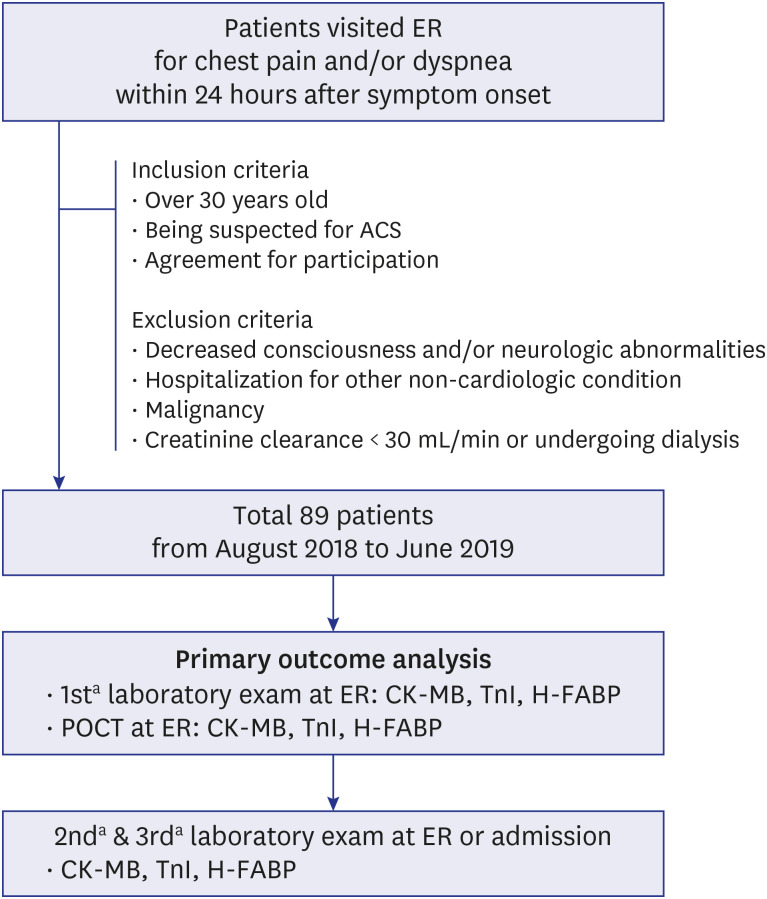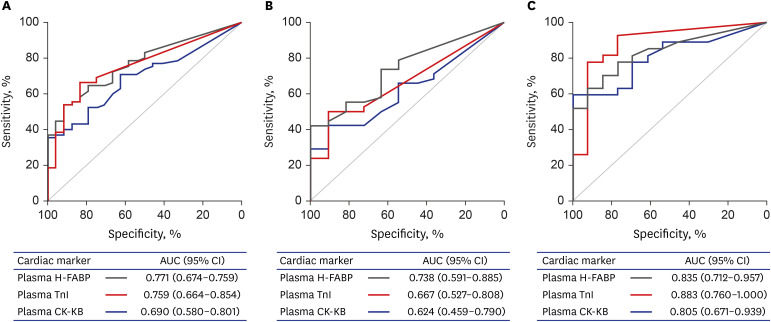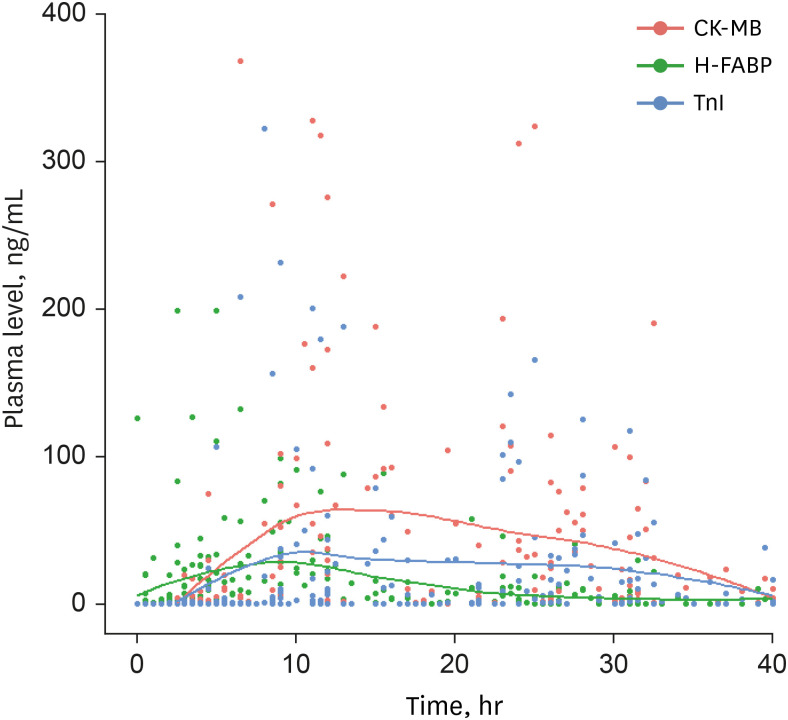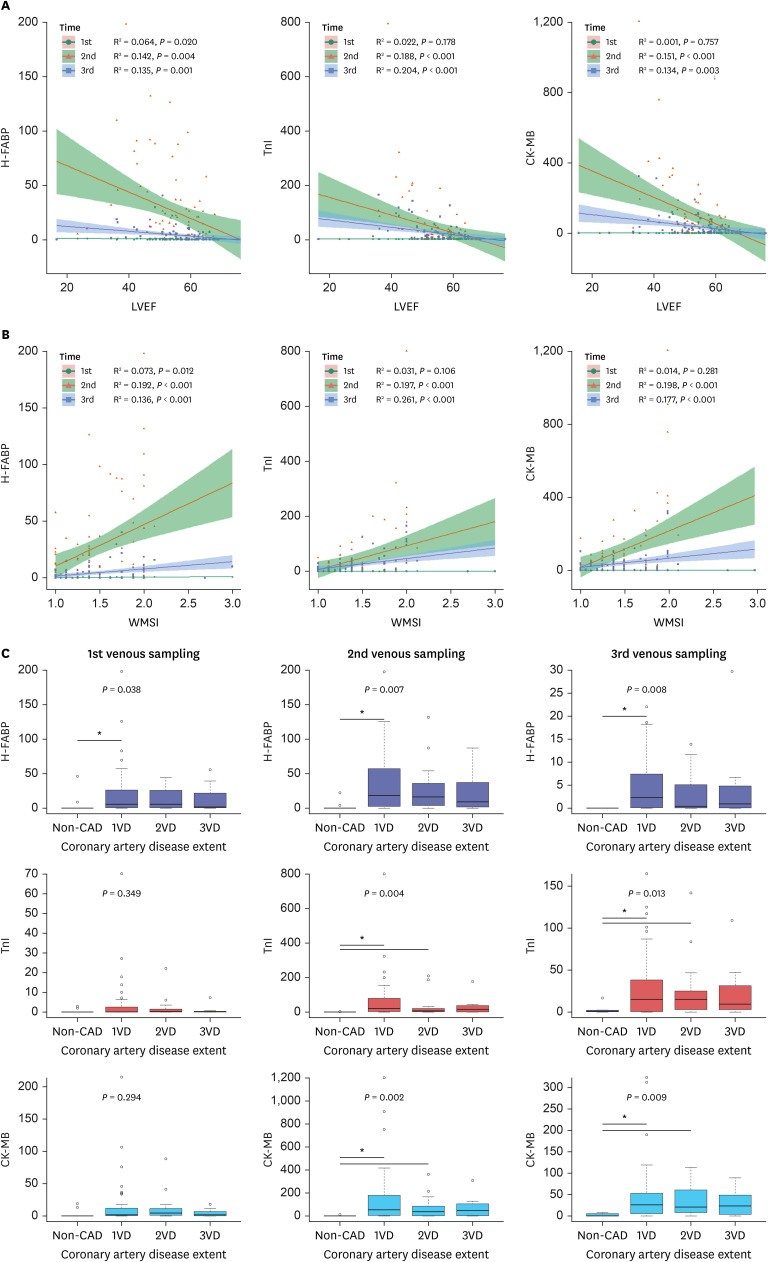J Korean Med Sci.
2021 Mar;36(8):e61. 10.3346/jkms.2021.36.e61.
Evaluation of Heart-type Fatty Acidbinding Protein in Early Diagnosis of Acute Myocardial Infarction
- Affiliations
-
- 1Cardiovascular Center, Seoul National University Bundang Hospital, Seongnam, Korea
- 2Department of Internal Medicine, College of Medicine, Seoul National University, Seoul, Korea
- 3Department of Laboratory Medicine, Seoul National University Bundang Hospital, Seongnam, Korea
- 4Department of Laboratory Medicine, College of Medicine, Seoul National University, Seoul, Korea
- KMID: 2513534
- DOI: http://doi.org/10.3346/jkms.2021.36.e61
Abstract
- Background
Although electrocardiography and cardiac troponin play important roles in the diagnosis of acute coronary syndrome (ACS), there remain unmet clinical needs. Heart-type fatty acid-binding protein (H-FABP) has been identified as an early diagnostic marker of acute myocardial infarction (AMI). In this study, we examined the diagnostic and prognostic value of H-FABP in patients suspected with ACS.
Methods
We conducted an observational single-center cohort study, including 89 adults aged 30 years or older, who presented to the emergency room (ER) within 24 hours after the onset of chest pain and/or dyspnea. We performed laboratory analysis and point-of-care testing (POCT) for cardiac markers, including H-FABP, troponin I, and creatine kinasemyocardial band. We also evaluated the correlation between cardiac markers and left ventricular (LV) dysfunction and extent of coronary artery disease (CAD).
Results
In patients presented to ER within 4 hours after symptom onset (n = 49), the diagnostic accuracy of H-FABP for AMI, as quantified by the area under the receiver operating characteristic curve, was higher (0.738; 95% confidence interval [CI], 0.591–0.885) than other cardiac markers. In POCT, the diagnostic accuracy of H-FABP (56%; 95% CI, 45–67) was significantly higher than other cardiac markers. H-FABP was correlated with not extent of CAD but post-AMI LV dysfunction.
Conclusion
H-FABP is a useful cardiac marker for the early diagnosis of AMI and prediction of myocardia injury. Difference in the circulatory release timeline of cardiac markers could explain its utility in early-stage of myocardial injury.
Keyword
Figure
Reference
-
1. Ibanez B, James S, Agewall S, Antunes MJ, Bucciarelli-Ducci C, Bueno H, et al. 2017 ESC Guidelines for the management of acute myocardial infarction in patients presenting with ST-segment elevation: the Task Force for the management of acute myocardial infarction in patients presenting with ST-segment elevation of the European Society of Cardiology (ESC). Eur Heart J. 2018; 39(2):119–177. PMID: 28886621.2. Roffi M, Patrono C, Collet JP, Mueller C, Valgimigli M, Andreotti F, et al. 2015 ESC Guidelines for the management of acute coronary syndromes in patients presenting without persistent ST-segment elevation: Task Force for the Management of Acute Coronary Syndromes in Patients Presenting without Persistent ST-Segment Elevation of the European Society of Cardiology (ESC). Eur Heart J. 2016; 37(3):267–315. PMID: 26320110.3. Reichlin T, Hochholzer W, Bassetti S, Steuer S, Stelzig C, Hartwiger S, et al. Early diagnosis of myocardial infarction with sensitive cardiac troponin assays. N Engl J Med. 2009; 361(9):858–867. PMID: 19710484.
Article4. Savonitto S, Ardissino D, Granger CB, Morando G, Prando MD, Mafrici A, et al. Prognostic value of the admission electrocardiogram in acute coronary syndromes. JAMA. 1999; 281(8):707–713. PMID: 10052440.
Article5. Ohman EM, Armstrong PW, Christenson RH, Granger CB, Katus HA, Hamm CW, et al. Cardiac troponin T levels for risk stratification in acute myocardial ischemia. N Engl J Med. 1996; 335(18):1333–1341. PMID: 8857016.
Article6. Thygesen K. ‘Ten commandments’ for the fourth universal definition of myocardial infarction 2018. Eur Heart J. 2019; 40(3):226. PMID: 30649367.
Article7. Reiter M, Twerenbold R, Reichlin T, Haaf P, Peter F, Meissner J, et al. Early diagnosis of acute myocardial infarction in the elderly using more sensitive cardiac troponin assays. Eur Heart J. 2011; 32(11):1379–1389. PMID: 21362702.
Article8. Twerenbold R, Jaffe A, Reichlin T, Reiter M, Mueller C. High-sensitive troponin T measurements: what do we gain and what are the challenges? Eur Heart J. 2012; 33(5):579–586. PMID: 22267244.
Article9. Willeit P, Welsh P, Evans JD, Tschiderer L, Boachie C, Jukema JW, et al. High-sensitivity cardiac troponin concentration and risk of first-ever cardiovascular outcomes in 154,052 participants. J Am Coll Cardiol. 2017; 70(5):558–568. PMID: 28750699.10. Glatz JF, van Bilsen M, Paulussen RJ, Veerkamp JH, van der Vusse GJ, Reneman RS. Release of fatty acid-binding protein from isolated rat heart subjected to ischemia and reperfusion or to the calcium paradox. Biochim Biophys Acta. 1988; 961(1):148–152. PMID: 3260112.
Article11. Tanaka T, Hirota Y, Sohmiya K, Nishimura S, Kawamura K. Serum and urinary human heart fatty acid-binding protein in acute myocardial infarction. Clin Biochem. 1991; 24(2):195–201. PMID: 2040092.
Article12. Kleine AH, Glatz JF, Van Nieuwenhoven FA, Van der Vusse GJ. Release of heart fatty acid-binding protein into plasma after acute myocardial infarction in man. In : van der Vusse GJ, Stam H, editors. Lipid Metabolism in the Healthy and Disease Heart. Boston, MA: Springer US;1992. p. 155–162.13. Seino Y, Ogata K, Takano T, Ishii J, Hishida H, Morita H, et al. Use of a whole blood rapid panel test for heart-type fatty acid-binding protein in patients with acute chest pain: comparison with rapid troponin T and myoglobin tests. Am J Med. 2003; 115(3):185–190. PMID: 12935824.
Article14. Okamoto F, Sohmiya K, Ohkaru Y, Kawamura K, Asayama K, Kimura H, et al. Human heart-type cytoplasmic fatty acid-binding protein (H-FABP) for the diagnosis of acute myocardial infarction. Clinical evaluation of H-FABP in comparison with myoglobin and creatine kinase isoenzyme MB. Clin Chem Lab Med. 2000; 38(3):231–238. PMID: 10905760.
Article15. O'Donoghue M, de Lemos JA, Morrow DA, Murphy SA, Buros JL, Cannon CP, et al. Prognostic utility of heart-type fatty acid binding protein in patients with acute coronary syndromes. Circulation. 2006; 114(6):550–557. PMID: 16880323.16. Kilcullen N, Viswanathan K, Das R, Morrell C, Farrin A, Barth JH, et al. Heart-type fatty acid-binding protein predicts long-term mortality after acute coronary syndrome and identifies high-risk patients across the range of troponin values. J Am Coll Cardiol. 2007; 50(21):2061–2067. PMID: 18021874.
Article17. Apple FS, Smith SW, Pearce LA, Murakami MM. Assessment of the multiple-biomarker approach for diagnosis of myocardial infarction in patients presenting with symptoms suggestive of acute coronary syndrome. Clin Chem. 2009; 55(1):93–100. PMID: 19028826.
Article18. Reiter M, Twerenbold R, Reichlin T, Mueller M, Hoeller R, Moehring B, et al. Heart-type fatty acid-binding protein in the early diagnosis of acute myocardial infarction. Heart. 2013; 99(10):708–714. PMID: 23514979.
Article19. Viswanathan K, Kilcullen N, Morrell C, Thistlethwaite SJ, Sivananthan MU, Hassan TB, et al. Heart-type fatty acid-binding protein predicts long-term mortality and re-infarction in consecutive patients with suspected acute coronary syndrome who are troponin-negative. J Am Coll Cardiol. 2010; 55(23):2590–2598. PMID: 20513600.
Article20. Bank IE, Dekker MS, Hoes AW, Zuithoff NP, Verheggen PW, de Vrey EA, et al. Suspected acute coronary syndrome in the emergency room: limited added value of heart type fatty acid binding protein point of care or ELISA tests: the FAME-ER (Fatty Acid binding protein in Myocardial infarction Evaluation in the Emergency Room) study. Eur Heart J Acute Cardiovasc Care. 2016; 5(4):364–374. PMID: 25906779.
Article21. Kitamura M, Hata N, Takayama T, Hirayama A, Ogawa M, Yamashina A, et al. High-sensitivity cardiac troponin T for earlier diagnosis of acute myocardial infarction in patients with initially negative troponin T test--comparison between cardiac markers. J Cardiol. 2013; 62(6):336–342. PMID: 23867331.
Article22. Glatz JF, van der Vusse GJ, Simoons ML, Kragten JA, van Dieijen-Visser MP, Hermens WT. Fatty acid-binding protein and the early detection of acute myocardial infarction. Clin Chim Acta. 1998; 272(1):87–92. PMID: 9581860.
Article23. McCann CJ, Glover BM, Menown IB, Moore MJ, McEneny J, Owens CG, et al. Novel biomarkers in early diagnosis of acute myocardial infarction compared with cardiac troponin T. Eur Heart J. 2008; 29(23):2843–2850. PMID: 18682444.
Article24. Kellens S, Verbrugge FH, Vanmechelen M, Grieten L, Van Lierde J, Dens J, et al. Point-of-care heart-type fatty acid binding protein versus high-sensitivity troponin T testing in emergency patients at high risk for acute coronary syndrome. Eur Heart J Acute Cardiovasc Care. 2016; 5(2):177–184. PMID: 25666938.
Article
- Full Text Links
- Actions
-
Cited
- CITED
-
- Close
- Share
- Similar articles
-
- Serum Myoglobin in the Early Phase of Acute Myocardial Infarction
- Immunohistochemical Study of Fibronectin for Postmortem Diagnosis of Early Myocadial Infarction
- The Diagnostic Value of h-FABP (hearttype fatty acid binding protein) in Acute Myocardial Infarction
- Three Cases of Ventricular Septal Rupture after Acute Myocardial Infarction
- A Case of Acute Fulminant Myocarditis Progressed into and Recovered from Congestive Heart Failure and Multiorgan Failure





